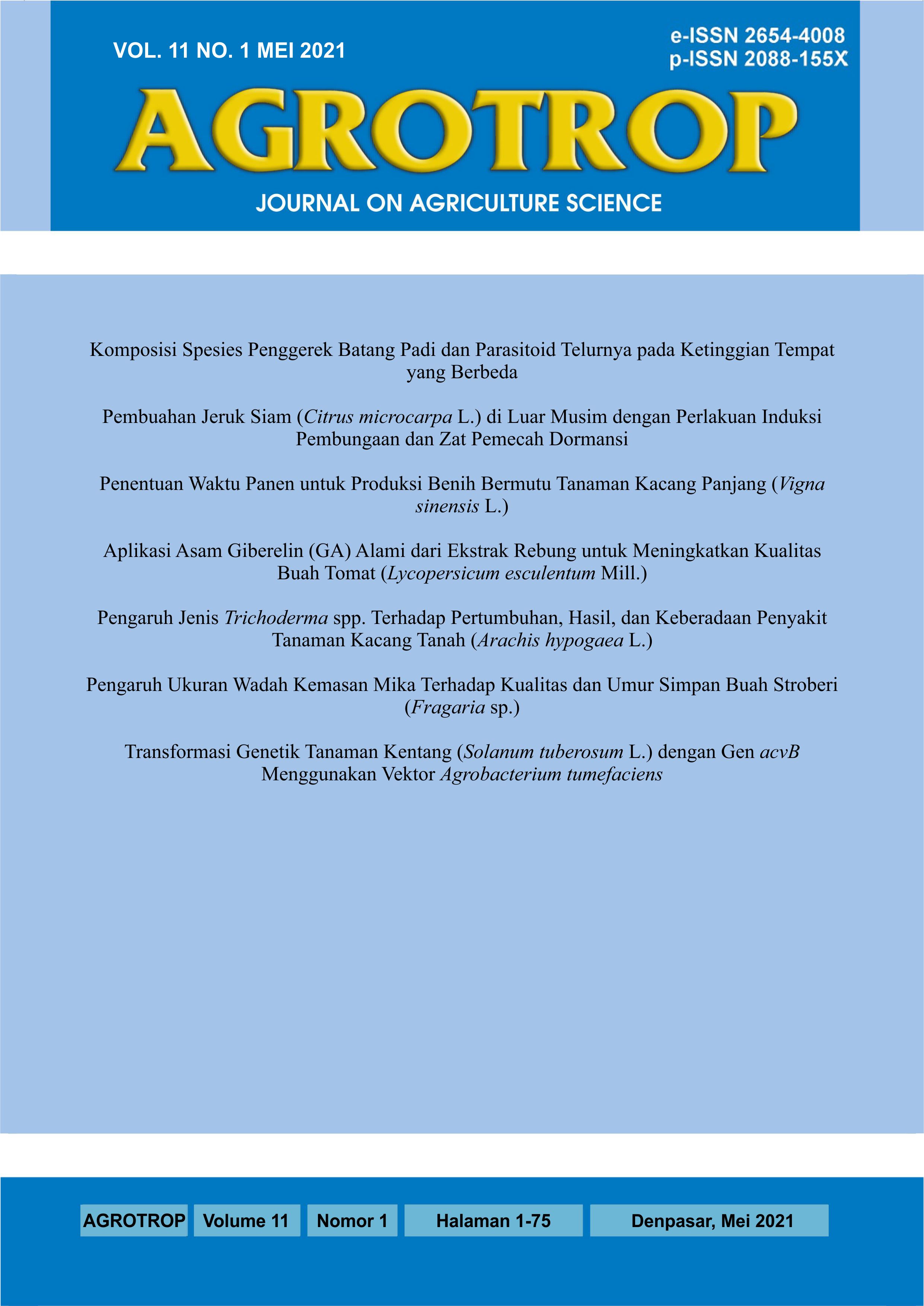Pengaruh Jenis Trichoderma spp. Terhadap Pertumbuhan, Hasil, dan Keberadaan Penyakit Tanaman Kacang Tanah (Arachis hypogaea L.)
Abstract
The Effect of Trichoderma spp. on Growth, Yield, and Presence of the Diseases in Peanut (Arachis hypogaea L.). The consumption of peanuts is increasing together with increasing population, increasing nutrition, food diversification and increasing the capacity of the food and animal feed industry. However, the supply of peanuts in Indonesia is continues decline due to low soil nutrients and leaf rust attacks. The efforts can be made to increase peanut productions by applying Trichoderma spp. in peanut seeds. The purpose of this study was to determine the effect of Trichoderma spp. on the growth and yield of peanut plants, identifying the effect of Trichoderma spp. on the resistance of peanut plants to disease and know the best type of Trichoderma spp. for peanut plants. The design used in this study was a randomized block design (RCBD) with the treatment of a single factor type Tricoderma spp. which consists of 7 levels, namely: control, T. koningii, T. viride, T.asperellum, T. harzianum, T. ressei and T. asperellum Bedugul Bali. The treatment was repeated 4 times. The experimental results showed that the treatment of Trichoderma spp. significant until very significant effect on most of the observation variables. The best Trichoderma spp. is T. asperellum which has a very significant effect on the total number of pods (24.25 pods), weight of pods contained/plant (62.43 g), number of seeds/plant (62.75 seeds), and lowest leaf rust intensity (34,51%).
Downloads
References
BPS. (2017). Prakiraan Produksi Palawija Hasil Rakor Pembahasan antara Kementan dan BPS Tahun 2012-2017.
Cikita, D., Khotimah, S., & Linda, R. (2016). Uji antagonis Trichoderma spp . terhadap Phytophthora palmivora Butl . penyebab penyakit busuk buah Kakao ( Theobroma cacao L .). Protobiont, 5(3), 59–65. http://jurnal.untan.ac.id/index.php/jprb/article/download/17016/14560
Damicone, J., & Melouk, H. (2013). Soilborne Diseases of Peanut. Oklahoma Cooperative Extension Service, 7. http://osufacts.okstate.edu
DitjenTP, D. J. T. P. (2012). Road Map Peningkatan Produksi Kacang Tanah dan Kacang Hijau Tahun 2010–2014. Direktorat Jenderal Tanaman Pangan.
Duaja, M., Arzita, & Redo, Y. (2012). Analisis Tumbuh Selada (Lactuca Sativa L) Pada Perbedaan Jenis Pupuk Organik Cair. Jurnal Universitas Jambi, 1(1), 33–41.
Hardianus, Suryantini, R., & Wulandari, R. S. (2017). Efektivitas trichoderma dan pupuk kandang terhadap pertumbuhan tinggi dan diameter semai acacia mangium pada tanah ultisol. Jurnal Hutan Lestari, 5(2), 521–529.
Haryadi, D., Yetti, H., & Yoseva, S. (2015). Pengaruh Pemberian Beberapa Jenis Pupuk Terhadap Pertumbuhan Dan Produksi Tanaman Kailan (Brassica alboglabra L.). JOM Faperta, 2(2), 1–10.
Meena, V., Maurya, B., & Bahadur, I. (2014). Potassium solubilization by bacterial strain in waste mica. Bangladesh Journal of Botany, 43(2), 235–237. https://doi.org/10.3329/bjb.v43i2.21680
Pandya, U., & Saraf, M. (2010). Role of Single Fungal Isolates and Consortia as Plant Growth Promoters under Saline Conditions. Research Journal of Biotechnology, 5(3), 5–9.
Parmar, P., & Sindhu, S. S. (2013). Potassium Solubilization by Rhizosphere Bacteria: Influence of Nutritional and Environmental Conditions. Journal of Microbiology Research, 3(1), 25–31.
Pratama, R. E., Mardhiansyah, M., & Oktorini, Y. (2015). Waktu Potensial Aplikasi Mikoriza dan Trichoderma Spp. Untuk Meningkatkan Pertumbuhan Semai Acacia mangium. JOM Faperta, 2(1).
Rahma, A. (2014). Pengaruh Pupuk Organik Cair Berbahan Dasar Limbah Sawi Putih (Brassica Chinensis L.) Terhadap Pertumbuhan Tanaman Jagung Manis (Zea Mays L. Var. Saccharata).
Sari, I. G. A. D. V. (2017). Identifikasi Penyebab Penyakit Layu pada Tanaman Stroberi (Fragaria sp.) di Desa Pancasari dan Potensi Pengendaliannya dengan Mikroba Antagonis. Universitas Udayana.
Sutedjo, M. M. (1995). Pupuk dan cara pemupukan (5th ed.). Rineka Cipta.
Viterbo, A., Landau, U., Kim, S., Chernin, L., & Chet, I. (2010). Characterization of ACC deaminase from the biocontrol and plant growth-promoting agent Trichoderma asperellum T203. FEMS Microbiology Letters, 305(1), 42–48. https://doi.org/10.1111/j.1574-6968.2010.01910.x
Wahyuno, D., Manohara, D., & Mulya, K. (2003). Peranan bahan organik pada pertumbuhan dan daya antagonisme Trichoderma harzianum dan pengaruhnya terhadap P. capsici. pada tanaman lada. Jurnal Fitopatologi Indonesia, 7, 76–82.
Yedidia, I., Benhamou, N., & Chet, I. (1999). Induction of Defense Responses in Cucumber Plants (Cucumis sativus L.) by the Biocontrol AgentTrichoderma harzianum. Applied and Environmental Microbiology, 65(3), 1061–1070. https://doi.org/10.1128/AEM.65.3.1061-1070.1999











